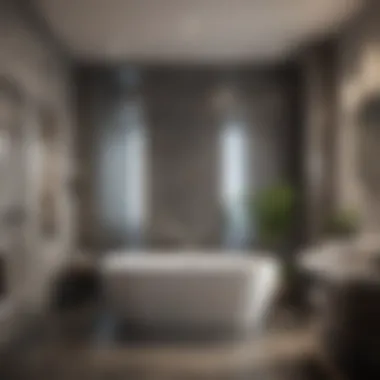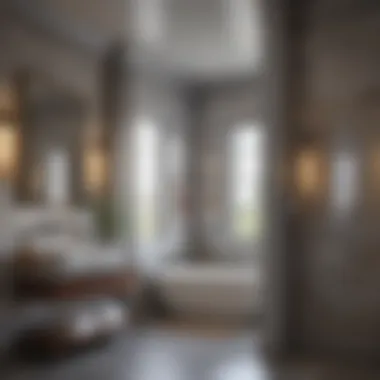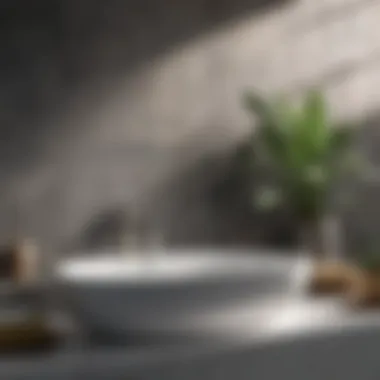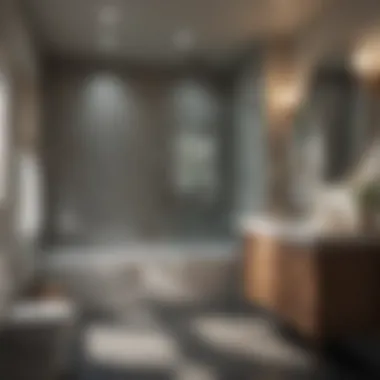Understanding Bathroom Addition Costs: A Comprehensive Guide


Intro
Embarking on a home renovation journey, particularly when it comes to adding a bathroom, can be quite complex. The decision not only involves aesthetics but also a host of financial considerations. Homeowners often find themselves caught between the desire for a modern spa-like retreat and the real-world constraints of a budget. Understanding the costs of this addition is not just about the initial outlay; it extends to ongoing expenses, potential ROI, and the nuances of design choices.
Having a grasp on the expenses involved can help mitigate the stress that often accompanies such home improvement projects. From the selection of materials to the size of the space, every decision carries weight and can impact your wallet significantly.
With fluctuations in the housing market and varying labor costs depending on where you live, it is essential to equip yourself with a solid understanding of the financial landscape that surrounds a bathroom addition. This article aims to break down these various elements, providing you with a well-rounded view that caters to your budgeting woes.
Trending Styles
Choosing the right style for your new bathroom can greatly influence your overall satisfaction and property value. Two popular design themes worth considering are Modern Minimalism and Cozy Rustic.
Modern Minimalism
This style emphasizes simplicity. It often features sleek lines, a clean color palette, and functionality over overly decorative elements. Homeowners who opt for this design typically favor:
- Neutral colors such as whites, grays, and blacks
- Open space layouts to create a feeling of vastness
- High-quality fixtures that blend aesthetics with practicality
A bathroom that embodies modern minimalism can feel serene and uncluttered, inviting relaxation into your daily routine.
Cozy Rustic
On the flip side, the cozy rustic style brings warmth and nostalgia into a space. Think of earthy tones, wooden accents, and perhaps, a vintage clawfoot tub. Elements that those leaning towards this style might appreciate include:
- Natural materials like wood and stone
- Warm color schemes with browns, greens, and creams
- Vintage or antique fixtures to enhance the charm
Rustic bathrooms can feel like a retreat from the chaos of everyday life, creating a sanctuary where one can unwind.
"The style you choose will not only reflect your personal taste but also resonate through the entire experience of using the space."
Color Palettes
The choice of color can set the mood for your new bathroom. Taking some time to understand which palettes align with your vision can save you hours of second-guessing later on. Two popular approaches include:
Calming Neutrals
Neutrals make for a relaxing escape from the hustle and bustle. Soft whites, light grays, and muted beige can enhance natural light and create an airy feel. This palette is often chosen for:
- Creating a sense of spaciousness
- Easy coordination with various fixtures and accessories
- Timeless appeal, ensuring you won't tire of the design easily
Bold Accents
Conversely, bold accents can introduce personality. A feature wall painted in a deep navy or vibrant emerald can pull the whole room together, centered around a striking focal point. Incorporating bold accents may involve:
- Choosing bright materials or tiles as a statement
- Mixing patterns for an eclectic feel
- Using high contrast to draw the eye around the space
Average Cost Overview
When contemplating a bathroom addition, understanding the overall costs can feel a bit like navigating a maze. You know there's a way out, but the twists and turns can be overwhelming. Having a solid grasp on the average cost landscape sets the stage for informed decision-making. Not just that, but it also provides clarity on what you can expect from this home improvement venture. The cost overview helps in aligning your desired outcomes with what’s realistically achievable within your budget.
Being well-versed in the costs equips homeowners with the knowledge needed to prioritize spending. Whether it's aiming for that luxury spa-like retreat or ensuring basic functionality, having insight into the average costs sets a foundation. Furthermore, this understanding aids in discussions with contractors, allowing you to communicate needs confidently.
General Cost Range
The average cost of adding a bathroom can vary dramatically based on multiple factors. Generally, homeowners might find themselves in a ballpark anywhere from $10,000 to $50,000. This range seems wide, but it accounts for a range of sizes, styles, and finishes. For example, if you decide to add a small powder room, costs will lean towards the lower end of the spectrum. A full master suite addition, on the other hand, brings in a hefty chunk and lands at the upper range.
Key Considerations for Cost Range:
- Size of the Addition: Larger spaces require more materials, labor, and potential alterations to existing plumbing.
- Location in the Home: Adding a bathroom near existing plumbing may save money compared to relocating plumbing fixtures.
- Design Complexity: Custom designs and layouts usually come with a price tag that reflects their intricacy.
Right off the bat, budgeting for a bathroom addition involves some heavy lifting. Knowing the general cost range gives a clear starting point. But bear in mind, this is just the surface.
Factors Affecting Costs
Diving deeper, it becomes clear that several factors ride shotgun in determining the cost of a bathroom addition. Here’s a closer look:
- Materials: The choice between cost-effective tiles and premium imported marble can swing the budget either way. Each decision influences the total.
- Labor: If you're hiring professionals, labor costs can creep up. Rates differ based on geography. For instance, urban areas typically face steeper labor wages in comparison to rural regions.
- Utilities: The existing plumbing infrastructure plays a pivotal role. Reworking existing lines could add significant costs if not considered from the get-go.
- Design Decisions: Simple layouts will likely keep costs down, whereas custom, intricate designs can add to the bill swiftly.
- Local Permits and Regulations: Depending on your region, necessary permits can vary in cost and complexity. Ignoring permit requirements could lead to fines or rebuilding, adding unexpected stress and expenses.
All these elements intertwine to affect the final outlay needed for a bathroom addition. Being cognizant of these influencers aids preparing realistic financial expectations that go beyond mere ballpark figures.
Size Considerations
When it comes to adding a bathroom, one of the most crucial factors to consider is size. This holds true not just because of the obvious spatial requirements, but also due to its broad implications on the overall cost and functionality of the unit. Choosing the right size can influence everything from materials to fixtures, and even the resale value of the home. Whether you're thinking about a cozy nook or a grand suite, size consideration is your first step in laying the groundwork for a successful addition.
Small Bathroom Additions


A small bathroom addition typically spans around 30 to 50 square feet. Many homeowners opt for this kind of addition because they can often squeeze it into a tight corner or a former closet space. The cost varies, but often it zips in at the lower end of the scale, mainly due to reduced material needs and shorter plumbing runs. When planning for a small bathroom, efficient use of space becomes vital.
- Layout: Think vertically. Utilizing wall space for shelves or cabinets can keep the area clutter-free.
- Fixtures: Choosing compact models for the sink and toilet can help maximize the available space.
- Light: Natural light or even strategic use of mirrors can make a small bathroom feel much larger.
Yet, don't let small size fool you into thinking less effort is required. Careful planning is still needed to ensure the end result is functional and aesthetically pleasing.
Medium Bathroom Additions
Medium-sized additions vary from about 50 to 100 square feet. This range allows for more flexibility in layout compared to a small addition and helps integrate more features like a larger shower or even a bathtub. While this means the budget typically rises, a well-designed medium bathroom can offer a balance of comfort and practicality without breaking the bank.
- Design flexibility: This is where you can start to consider different design elements such as double sinks, wider countertops, or a separate enclosed shower.
- Ventilation: It’s crucial to think about how air will circulate in this larger space to avoid moisture issues.
- Accessibility: If you plan on growing old in your home or simply want to cater to future buyers, considering accessible design elements, like grab bars or non-slip flooring, could add significant appeal.
Large Bathroom Additions
For homeowners contemplating a larger addition, often exceeding 100 square feet, the opportunities are endless. Large bathroom additions usually allow for luxurious features like soaking tubs, walk-in showers, double vanities, or even separate toilet areas. While these spaces can be lavish, they also often come with hefty price tags.
- Materials: Higher volume spaces usually require more robust materials. Splurging on premium tiles or fixtures can transform a bathroom into a true sanctuary.
- Plumbing Needs: More extensive plumbing may be a consideration here, as you may decide to install a bidet or multiple sinks.
- Heating and Cooling: With more square footage, proper HVAC considerations become essential to ensure comfort year-round.
When considering a large bathroom addition, understand that they often yield a higher return on investment, but they can also require more in-depth planning and budgeting.
In summary, whether you’re going for a small, medium, or large addition, each brings its own set of challenges and considerations. Deciding on the right size is foundational in not only optimizing your investment but also in ensuring your new bathroom fits seamlessly into your home.
Design and Layout
When considering adding a bathroom to your home, design and layout are key components that can make or break the success of the project. A thoughtfully designed bathroom not only boosts functionality but also enhances the overall aesthetic of the space. Here are a few reasons why these elements deserve special attention.
Good design can greatly impact the experience of using the bathroom. An efficient layout ensures ease of movement and accessibility for all family members, making daily routines a breeze. Additionally, investment in smart design can translate into higher property value, making it a wise financial decision in the long run.
Open Concept vs. Traditional
The choice between an open-concept and traditional layout presents a fundamental dilemma. Open-concept bathrooms allow for a seamless flow between spaces, creating a more airy and spacious feel. However, this layout comes with its set of challenges. For instance, privacy can take a back seat, which might be an issue for households with several members. The benefit, however, is the opportunity for more natural light, making the space feel even larger and inviting.
On the flip side, traditional layouts often provide defined boundaries that can enhance privacy. This kind of design typically features segmented spaces, with walls separating the shower, toilet, and sink. While this could potentially make a bathroom feel smaller, it allows for better soundproofing and personal space. The flip side, perhaps, is the opportunity for wasted space if not utilized wisely. In essence, the choice hinges on personal preference and lifestyle needs.
In deciding between open-concept and traditional, consider not only aesthetics but also how your family interacts within the space daily.
Essential Features
As you visualize your new bathroom addition, certain essential features should take center stage in your design plan. Here are some must-consider elements:
- Vanity and Storage: A well-thought-out vanity can significantly enhance functionality. Think about storage space for toiletries, towels, and cleaning supplies. Products like IKEA's Godmorgon series can offer stylish yet practical solutions.
- Lighting: Good lighting elevates the ambiance and functionality. Consider a mix of task, ambient, and accent lighting to tailor the atmosphere to your preference.
- Ventilation: Proper ventilation is often overlooked but is crucial to prevent mold and odors. Opt for a good-quality exhaust fan to keep the air fresh.
- Safety Features: For households with children or elderly persons, features that enhance safety—like non-slip flooring and grab bars—should be considered.
- Water-efficient Fixtures: Selecting water-saving lights and faucets not only lessens environmental impact but can lead to long-term savings on utility bills.
These elements combined can create a bathroom that balances form and function, ensuring that it meets both aesthetic desires and practical needs.
Material Selection
The selection of materials for a bathroom addition is not just a trivial task; it holds considerable weight in various aspects of the project. This pivotal step influences the overall aesthetic, durability, and even the financial implications of your addition. The right materials can elevate the design, ensuring your new bathroom melds seamlessly with the existing structure. Conversely, poor choices can lead to unnecessary costs, maintenance headaches, and an unappealing space.
When homeowners consider a bathroom addition, they often find themselves at a crossroads—should they opt for cost-effective materials that promise value, or splurge on premium options that gleam with luxury? The material selection process is more than just picking tiles or fixtures; it is about establishing a foundation for functionality and lifestyle.
Cost-Effective Materials
Choosing cost-effective materials doesn't mean compromising quality. It means understanding how to balance budget and performance. For instance, laminate countertops often mimic the look of stone at a fraction of the price. They’re durable and easy to maintain, making them a popular choice for those looking to save while still achieving a stylish finish.
Here are some common options for cost-effective materials:
- Vinyl Flooring: Water-resistant and available in a myriad of designs, it's a practical choice for bathrooms.
- Fiber-Cement Siding: A durable, moisture-resistant option for exterior walls that won’t blow the budget.
- Prefabricated Shower Units: These can drastically cut down installation time and costs compared to custom designs.
Using these materials not only keeps the renovation budget in check, it allows room for other enhancements, such as better lighting fixtures or modern plumbing.
"Knowing how to mix and match materials can be the difference between an efficient remodel and a costly overhaul."
Premium Materials
On the other side of the spectrum are premium materials, which often attract discerning homeowners aiming for high-end finishes. These materials not only offer superior aesthetics but tend to come with added benefits. For example, natural stone tiles provide an unmatched luxury feel, but they also require more maintenance.
Consider these premium materials:
- Marble Countertops: Elegant yet functional, offering durability and a visual statement.
- Hardwood Cabinetry: Brings warmth and richness to any bathroom, but requires care to avoid moisture damage.
- Custom Tile Work: A designer’s dream that allows for personalization but can significantly increase labor costs.
Investing in these premium choices can significantly increase the visual appeal and value of your property. However, it’s essential to assess whether the added costs align with your long-term goals for the home.
Labor Costs
When diving into the financial waters of a bathroom addition, one cannot overlook the importance of labor costs. These expenses can significantly sway the overall budget and usually take up a solid chunk of the funding. Whether you opt for hiring skilled contractors or roll up your sleeves and tackle the project yourself, understanding labor costs is crucial for effective budgeting.


Labor costs generally hinge on several factors, including the complexity of the design, the size of the project, and the local market rates for skilled tradespeople. Hence, knowing where you stand regarding labor pricing helps avoid those unpleasant surprises that can pop up during construction.
Hiring Contractors
Bringing in professionals can save both time and headaches. The expertise that contractors offer may be worth the extra penny, especially for structural alterations or complex plumbing and electrical systems.
Keep in mind that contractor fees can vary widely based on experience, reputation, and geographic location. For example, hiring a contractor in a bustling city like New York may cost significantly more than hiring someone in a quieter rural area.
When looking for contractors, it’s wise to:
- Get multiple quotes: This allows you to find competitive pricing.
- Check reviews: Always peruse feedback from previous clients to gauge reliability and quality.
- Ask for portfolios: A glance at past work can help gauge skill level and style compatibility.
- Understand the payment structure: Knowing how and when payments are due is vital to avoid any misunderstandings.
Consulting with contractors can also offer insights into the best materials to use and design specifications that align with your budget—hints that can save you time and money in the long run.
DIY vs. Professional Help
The decision to go the DIY route can be alluring. After all, who doesn’t want to boast about their handiwork during family gatherings? However, the reality might differ once you’re knee-deep in tile grout and plumbing.
Opting for DIY can save on labor costs, yet a few important factors must be weighed:
- Experience in home renovations: If you’ve tackled home projects before, you might be prepared for this one. If not, consider the learning curve.
- Time commitment: Are you ready to devote your weekends and evenings for an extended period? This project can take longer than expected.
- Potential errors: Mistakes in major projects can lead to greater costs down the line, whether it’s hiring someone to rectify issues or replacing faulty work.
On the flip side, hiring professionals might seem steep at first, but their time efficiency, expertise, and access to better materials can often balance out the costs. Ultimately, weighing the pros and cons of DIY against hiring pros will lead to a more informed and financially sound decision.
"Budget considerations often get clouded by enthusiasm for a DIY project. Remember, time is money, especially in home renovations."
Ultimately, labor costs should be a fundamental part of any budgeting plan for a bathroom addition. Taking the time to choose the best option for your specific situation can make all the difference between a smooth project and a bumpy ride.
Regional Variations in Pricing
When it comes to an undertaking like a bathroom addition, costs are not set in stone—it all depends on where you live. Regional variations in pricing play a critical role in determining the total expenditure for such projects. These variations can be influenced by a number of factors, including labor availability, cost of materials, and the local economy. Homeowners must consider these variations as they can significantly affect their budget and project timeline.
Urban vs. Rural Areas
In big cities, bathroom additions often come with an inflated price tag. The high cost of living, coupled with a more competitive market for contracting services, can make your project more expensive in urban areas. For instance, labor rates in metropolitan regions can soar due to demand and scarcity. Large cities like New York or San Francisco can see rates that are through the roof compared to rural counterparts. It's not unusual for labor costs to reach $100 per hour in these bustling areas.
Conversely, rural areas usually provide a more cost-effective option. Labor might be less expensive, but that doesn't mean it's without challenges. Sourcing materials could become an issue if the area lacks suppliers. Moreover, fewer local contractors could mean less competition, leading to higher prices due to limited options. Therefore, weighing these pros and cons is key when planning your bathroom addition.
State-Specific Trends
State-specific market trends also affect bathroom addition costs significantly. A project in California is likely to cost differently than one in Texas or Florida. Factors such as state regulations, economic conditions, and even climate can influence this.
- California has stringent regulations and high material costs, which could inflate your overall budget.
- Texas, on the other hand, often sees more manageable prices for both labor and materials, making it a more attractive choice for homeowners.
- Florida presents its own unique challenges, including hurricane-resistant building codes, which can add to material and labor costs.
Understanding local laws and building codes is also fundamental when you plan your addition. Not every state has the same requirements, and non-compliance can lead to additional expenses down the road.
"It's essential to research local market trends before starting your bathroom addition to ensure you don't get caught off-guard by unexpected costs."
In essence, regional variations can determine the feasibility of your project. They influence everything from labor to materials, and understanding them is critical for any homeowner considering a bathroom addition. It's worth taking the time to research not just local pricing, but also potential economic shifts that might affect the construction industry, as those will inevitably ripple through your budget and timeline.
Financing a Bathroom Addition
When planning a bathroom addition, the financial implications loom large. Understanding the financing options available can be the difference between a stress-free project and a potential financial headache. As many homeowners pursue the dream of expanding their home's functionality with an extra bathroom, knowing how to cover those costs is vital. This section delves deep into various financing avenues, unpacking the benefits and potential pitfalls for each.
Home Equity Loans
Home equity loans are often the route many choose when looking to fund a bathroom addition. This type of loan allows homeowners to borrow against the equity they’ve built in their property. If you've owned your home for a while, the gains in property value could mean substantial equity.
Here’s the gist:
- Low Interest Rates: Home equity loans generally offer lower interest rates compared to personal loans, as they are secured by the home itself.
- Tax Benefits: In some cases, the interest paid on these loans can be tax-deductible, which is a nice perk for savvy homeowners looking to reduce their tax burden.
However, getting a home equity loan isn’t without its risks. If repayment becomes an issue, you could risk losing your home. So, thinking twice before jumping in is always wise.
"When considering a home equity loan, remember: it’s not just about the money, but about securing your financial future as well."
Personal Loans
For those without substantial equity, personal loans become a viable option for financing a bathroom addition. These loans are typically unsecured, meaning they don't require collateral—but that often translates to higher interest rates.
Key points to consider:
- Flexibility: Personal loans can be used for a range of costs beyond just construction, including furnishings and decor.
- Quick Processing: They can often be processed relatively quickly, making them attractive for those in a hurry.
Nonetheless, the higher interest rates can accumulate over time, leading to a larger repayment amount. Taking the time to compare rates from various lenders can be beneficial.


Budgeting Considerations
Budgeting for a bathroom addition requires a clear-eyed appraisal of costs and financing avenues. Without a solid budget, projects can easily spiral out of control. Here are steps to consider:
- Establish a Total Cost Estimate: By obtaining quotes from contractors and assessing the total investment needed, you’ll formulate a clear number to work with.
- Set a Contingency Fund: It's best practice to save an additional 10%-15% beyond your estimate for those unforeseen costs that may pop up during construction.
- Evaluate Priorities: Determine what features are non-negotiable versus those that are more flexible. Having a clear understanding of this can help guide decisions as you make financial allocations.
Being informed about each step of the budgeting process creates a smoother path toward that beautiful new bathroom, ensuring your finances don’t end up in hot water.
Return on Investment
When homeowners embark on a bathroom addition project, one of their predominant concerns often revolves around the potential Return on Investment (ROI). This consideration transcends mere monetary value; it encapsulates the emotional and functional benefits derived from enhancing one's living space. Properly assessing ROI can steer homeowners toward smarter choices, influencing both initial spending and the long-term value of their property.
Market Trends
Understanding current market trends is crucial in estimating the ROI of a bathroom addition. Homebuyers frequently cite bathrooms as significant determinants in property appeal. According to various real estate reports, houses that feature modern, well-appointed bathrooms tend to sell faster and at higher prices compared to their counterparts lacking such amenities.
Additionally, the trend of embracing sustainable and energy-efficient fixtures continues to gain traction. Homebuyers are not just looking for aesthetic appeal; they're also keen on features that promise long-term savings on utilities. Installing energy-efficient lighting or low-flow fixtures can become attractive selling points, enhancing ROI.
- In Demand Features:
- Neglected Features:
- Spa-like amenities
- Modern fixtures
- Smart home technology
- Outdated designs
- Poor ventilation
- Inaccessible spaces
Staying abreast of these trends ensures that your investment aligns with what the market currently values. This approach can ultimately translate into a higher sale price when the time comes to part ways with the property.
Increasing Home Value
The statistical correlation between bathroom additions and increased home value cannot be ignored. According to the National Association of Realtors, homeowners typically see an ROI of around 50% to 70% for bathroom remodels, depending on factors like initial costs and geographical locations. It's vital for homeowners to recognize that quality renovations stand out during appraisals and inspections.
Investing in high-quality materials and tasteful designs can be pivotal for maximizing value. A beautifully renovated bathroom can position your property favorably in comparison to similar homes in the area, making it a distinguishing feature that potential buyers will likely prioritize.
The idea that a bathroom addition is merely a functional improvement underestimates its qualitative benefits. Beyond numbers, well-executed additions enhance the everyday experience of living in the home. Navigating mornings becomes less of a rush when all family members have access to dedicated spaces. Hence, the emotional value tied to a bathroom addition should factor into ROI considerations.
In a nutshell, the ROI from a bathroom addition is influenced by both market trends and tangible increases in home value. By keeping these elements in check, you can ensure not only a sound financial investment but also an enhancement that elevates your daily living experience.
"A bathroom addition isn't just a remodel; it's an investment in comfort and future value."
Ultimately, thoughtful planning and research can ensure that your bathroom addition becomes a worthwhile venture, effectively boosting not only the marketability of your home but also enhancing the quality of life for you and your family.
Permits and Regulations
When venturing into the complexities of a bathroom addition, understanding the realm of permits and regulations is pivotal. Not only do these frameworks exist to ensure safety and compliance, but they also safeguard your investment. Failing to adhere to local laws can lead to complications, which can be costly in both time and money.
Necessary Permits
Before you raise your hammer, it is crucial to check what permits are required in your area. In many municipalities, a building permit is necessary for most bathroom renovations, especially if structural changes are involved. Here are some common permits you might need:
- Building Permit: This usually covers significant alterations, ensuring that your plans meet safety standards.
- Electrical Permit: If you're upgrading or adding electrical outlets, this permit is essential.
- Plumbing Permit: Any new plumbing connections will need approval from local authorities to avoid costly repairs down the line.
- Permit for HVAC: If your renovation impacts heating or cooling systems, this permit might be needed as well.
Obtaining these permits can be a tedious task, but don’t let this deter you. It’s about making sure everything is above board. Furthermore, permits help in upholding the value of your home. Without them, you might face fines or even compel you to undo work already done.
Building Codes Compliance
Building codes are like the rulebook for construction. Each code sets strict standards regarding safety, design, and materials. Here are just a few reasons why compliance is non-negotiable:
- Safety: Codes are established to keep occupants safe from hazards, such as electrical fires or plumbing failures.
- Property Value: When the time comes to sell, having compliant renovations can ease the selling process, making your property more attractive to buyers.
- Insurance: If you have additions that don’t comply with local codes, you might face issues when filing insurance claims.
Homeowners often tend to overlook the significance of stringent adherence to building codes. A casual approach can lead to dire consequences, including the need to redo work or pay fines. Always consult with a professional who understands the local codes specific to bathroom additions.
"It's better to take the long road and do things rightly than to shortcut it and pay for it later."
In summary, dealing with permits and building codes might seem like a cumbersome process but it pays dividends in the long run. Take the time to understand what is needed before breaking ground on your bathroom addition.
End
When considering a bathroom addition, the financial aspect plays a significant role in shaping the decision. In this article, we’ve covered various elements that affect overall costs, helping you navigate the complexities that come with such an investment. A bathroom isn't just a functional space; it can be a sanctuary, a retreat after a long day, or even a boost to your property's value.
Understanding the costs associated with a bathroom addition goes beyond just numbers. It’s about making informed choices that resonate with your lifestyle and long-term financial goals. From the size of the addition to the selection of materials, every choice matters. Coupled with labor costs and regional pricing differences, homeowners have a laundry list of considerations. Here are some benefits of delving into these costs:
- Budgeting Precision: By breaking down costs, you gain clarity about what you can afford and where to save.
- Value Assessment: Evaluating ROI helps you understand if the expense is worth the potential increase in property value.
- Enhanced Planning: Knowing the costs allows for better planning of timelines, materials, and labor, which can mitigate unexpected surprises later.
In summary, educating oneself about the financial implications of a bathroom addition informs smarter decisions, ultimately leading to a favorable outcome that caters to both your immediate needs and future aspirations.
Final Thoughts on Costs
Ultimately, the costs associated with a bathroom addition are contingent upon numerous factors. It’s paramount to realize that these additions can vary widely in price from one project to another due to several aspects such as design choices, geographical location, and labor availability. For example, homeowners in metropolitan areas often face higher labor costs compared to those in rural locales, not to mention that different regions might require distinct permits and adherence to codes.
If you're ready to jump into this project, consider reaching out to professionals to gain tailored estimates, thus ensuring you're not leaving any stone unturned. Being well-informed sets the stage for crafting a space that adds both utility and delight to your home.
To conclude, weigh each element carefully. The knowledge gathered in this article provides a framework for understanding what it takes financially to add a bathroom to your beloved abode. Make these insights work for you as you embark on creating a space that mirrors your vision.















